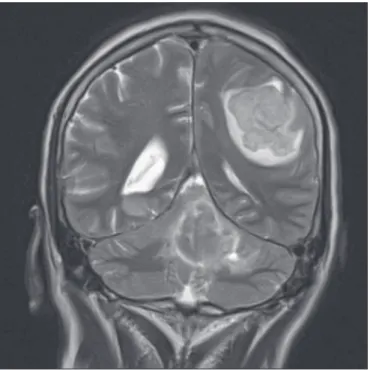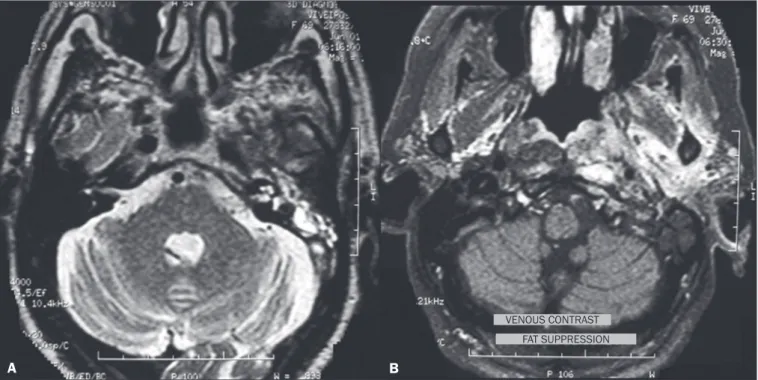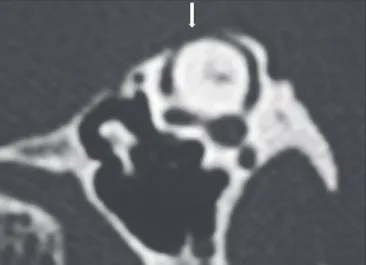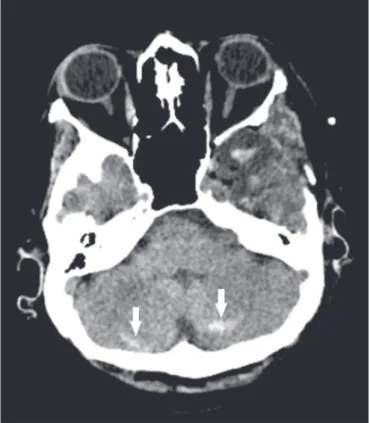328 Radiol Bras. 2017 Set/Out;50(5):328–334 Abstract
Resumo
Dizziness is a prevalent symptom in the general population, accounting for a considerable share of physician ofice visits, and most causes are clinically treatable. It is also a common indication for neuroimaging studies, in order to identify a speciic etiology and ex -clude surgical causes. Here, we illustrate the main peripheral and central causes of dizziness, discussing their possible differential diagnoses, as well as their most important image aspects.
Keywords: Dizziness; Vertigo; Neuroimaging; Computed tomography; magnetic resonance imaging.
Tontura é sintoma prevalente na população geral e responsável por uma parcela considerável de idas ao consultório médico, sendo
a maior parte das causas tratáveis clinicamente. Além disso, é indicação frequente nos exames de neuroimagem, a im de deinir uma causa especíica e excluir possíveis causas cirúrgicas. Neste ensaio ilustramos as principais causas periféricas e centrais de
tontura, discutindo seus possíveis diagnósticos diferenciais, bem como seus aspectos de imagem mais relevantes.
Unitermos: Tontura; Vertigem; Neuroimagem; Tomograia computadorizada; Ressonância magnética.
Study conducted in the Radiology Department of the Hospital Casa de Portugal, Rio de Janeiro, RJ, Brazil.
1. Masters Student, MD, Neuroradiologist at the Instituto Estadual do Cérebro Paulo Niemeyer, Rio de Janeiro, RJ, Brazil.
2. Full Member of the Colégio Brasileiro de Radiologia e Diagnóstico por Imagem (CBR), MD, Radiologist at the Hospital Universitário Walter Cantídio, Fortaleza, CE, Brazil.
3. MD, Radiologist at the Hospital Casa de Portugal/3D Diagnóstico por Ima-gem, Rio de Janeiro, RJ, Brazil.
4. Full Professor at the Universidade Federal do Rio de Janeiro (UFRJ), Rio de Janeiro, RJ, Brazil.
Mailing address: Dr. Bruno Niemeyer de Freitas Ribeiro. Instituto Estadual do Cé-rebro Paulo Niemeyer – Departamento de Radiologia. Rua do Rezende, 156, Centro. Rio de Janeiro, RJ, Brazil, 22231-092. E-mail: bruno.niemeyer@hotmail.com.
Received March 25, 2016. Accepted after revision May 21, 2016.
DISCUSSION
Various etiologies are associated with dizziness. Therefore, as part of the initial evaluation, cardiovascular, endocrine, pharmacological, and psychiatric causes need to be excluded before imaging studies are considered.
In this study, we will discuss imaging indings related to dizziness. We have organized those indings by etiologic class, including neoplastic, infectious/inlammatory, ana -tomical, traumatic/postoperative, and other causes.
Neoplastic causes
Meningioma
Meningioma is the most common extra-axial tumor in adults and the second most common lesion in the cer-ebellopontine angle. Meningiomas usually have a homo-geneous appearance on computed tomography (CT) and magnetic resonance imaging (MRI), with intense contrast enhancement (Figure 1). The presence of the dural tail
sign is suggestive of, although not speciic for, the diag -nosis. Despite slow growth, when located in the posterior fossa, meningiomas can have a compressive effect on the cerebellum, consequently causing dizziness(3).
Schwannoma
Schwannoma is the most common lesion in the cer-ebellopontine angle, usually (when small) has a homoge-neous appearance, and presents the Antoni A type of his-tological pattern. Insinuation into and enlargement of the internal auditory canal, as depicted in Figure 2, is
sugges-INTRODUCTION
The ability of human beings to remain upright, to accelerate, and to rotate, without wavering or falling, is called equilibrium, or balance. The maintenance of bal-ance requires appropriate interaction among the vestibu-lar, visual, and proprioceptive systems(1). Disturbances in the relationship among these systems usually manifest as dizziness. Dizziness occurs in 5–10% of the world popula-tion and in 65% of individuals over 65 years of age(1). The term is nonspeciic and usually covers a range of presen -tations, the most common being vertigo (a false sensation of bodily movement), disequilibrium, and presyncope(2).
Vertigo is more often associated with disorders of the ves-tibular system and its connections, whereas disequilibri-um is usually associated with neurological damage(2), and
tive of, although not speciic for, the diagnosis. The main
nerve involved is the eighth cranial nerve, manifesting mainly with tinnitus and hearing loss, although schwan-nomas can cause dizziness when they exert a compressive effect on the cerebellum(3).
Hemangioblastoma
Hemangioblastomas are more common in the cer-ebellum, are associated with von Hippel–Lindau disease, and can be accompanied by polycythemia, because they are capable of producing erythropoietin(4). They are often cystic tumors with a solid mural component; purely solid
Hemangioblastomas, which have a higher rate of local re-currence, occur in 30% of cases(4). They are lesions with
high contrast uptake, and, on MRI, the solid component shows an isointense signal on T1-weighted images and a hyperintense signal on T2-weighted images, sometimes being accompanied by facilitated diffusion, as shown in Figure 3(4,5).
Glomus jugulare and glomus jugulotympanicum tumors
Glomus jugulare and glomus jugulotympanicum, tu-mors of the chemoreceptor system, are the main primary tumors of the jugular foramen. The majority of such tu-mors are benign, they present aggressive behavior. On CT,
they manifest as irregular bone destruction with signii -cant contrast enhancement. On MRI, they present low signal intensity on T1-weighted images and high signal
intensity on T2-weighted images, also with signiicant
contrast enhancement. Larger glomera can present
inter-nal low voids(6), as depicted in Figure 4.
Endolymphatic sac tumor
Endolymphatic sac tumors are rare tumors of the pos-terior region of the petrous portion of the temporal bone that are slow growing and occur sporadically in most cas-es. Although they are not malignant, they are locally inva-sive. In 15% of cases, endolymphatic sac tumors are asso-ciated with von Hippel-Lindau disease(4). On CT, the bone destruction is either geographic or has a moth-eaten
ap-pearance, with a peripheral rim of calciication. On MRI,
Figure 2. Schwannoma. Contrast-enhanced axial T1-weighted MRI sequence. Patient with type 2 neuroibromatosis presenting bilateral (right) schwannoma, extending to the internal auditory canal (arrow), with a meningioma (arrow-head) visible in the left middle fossa.
Figure 3. Hemangioblastoma. Contrast-enhanced axial T1-weighted MRI se-quence showing a solid-cystic lesion, with intense enhancement of the solid portion, affecting the right cerebellar hemisphere.
Figure 1. Meningioma. Contrast-enhanced, axial T1-weighted MRI sequence, showing a homogeneous meningioma (arrow), with intense enhancement, located in the posterior fossa and encroaching upon the adjacent cerebellar parenchyma.
the signal is heterogeneous, with hyperintense foci seen within the lesion in a T1-weighted sequence (Figure 5).
Metastasis
Metastases are the principal malignant neoplasm involving the brain and are more common in the supra-tentorial compartment because of its greater vasculariza-tion. When they occur in the infratentorial compartment, they often provoke dizziness. The most common primary sites are the breast, lung, kidney, stomach, and prostate.
There are no speciic imaging features, making it dificult
to differentiate metastases from other lesions. Metastases
otomastoiditis commonly presents as material with a hy-pointense signal, without bone erosion. On MRI, no re-stricted diffusion is expected. When not treated properly, it can progress to osteomyelitis (Figure 9) or intracranial
Figure 5. Endolymphatic sac tumor. Non-contrast-enhanced axial T1-weighted MRI sequence. Patient with von-Hippel-Lindau disease presenting a bilateral endolymphatic sac tumor (arrows).
Figure 6. Metastasis. Coronal T2-weighted MRI sequence. Patient with breast neoplasm presenting two lesions with perilesional edema.
Figure 4. Glomus tumor. Contrast-enhanced axial T1-weighted MRI sequence showing a lesion with marked enhancement (arrow), containing areas consis-tent with low voids.
VENOUS CONTRAST
FAT SUPPRESSION
Acute cerebellitis
Most common in children, acute cerebellitis is en-cephalitis that is restricted to the cerebellum, affecting one or both hemispheres (Figure 12). Although the vari-complications, including meningitis, abscesses (Figure
10), and venous thrombosis. The incidence of those com-plications has declined substantially because of the wide-spread use of antibiotics.
Cholesteatoma
Cholesteatoma involves proliferation of keratinized
stratiied squamous epithelium, with pathological char -acteristics identical to those of epidermoid cyst. It can
be acquired or congenital, occurring in the pars laccida
or pars tensa. In most cases, it is acquired and occurs in
the pars laccida. On CT, cholesteatomas typically appear
as lesions with soft-tissue density in Prussak’s space, ac-companied by erosion of the ossicular chain and lateral wall of the attic (epitympanic recess), and can also be
ac-companied by labyrinthine istulas. In functional diffu -sion-weighted MRI sequences, cholesteatomas show high
signal intensity, facilitating the distinction with inlamma -tory granulation tissue (Figure 11).
Figure 9. Osteomyelitis-complicated otomastoiditis. Coronal CT, with a bone window, showing bone sequestration (arrow) within right-sided otomastoiditis.
Figure 10. Cerebellar abscess-complicated otomastoiditis. Gadolinium-con-trast-enhanced axial T1-weighted MRI sequence showing a lesion with en-hancement of its walls, involving the cerebellum.
Figure 8.Pseudomonas aeruginosa otomastoiditis in a patient with poor glycemic control. A: Axial T2-weighted MRI sequence showing left-sided otomastoiditis with marked involvement of the ipsilateral labyrinth. B: Contrast-enhanced axial T1-weighted MRI sequence of the same patient. Note the extensive involvement, even reaching the masticator space.
A B
VENOUS CONTRAST
cholesteatoma (arrow) with a hyperintense signal.
Figure 12. Cerebellitis caused by infection with the Epstein-Barr virus. Axial slice in a luid-attenuated inversion recovery sequence, showing diffuse hyper -intensity in the cerebellum, especially in the right hemisphere.
Figure 13. Ramsay Hunt syndrome. A: Coronal T1-weighted MRI sequence showing enlargement of the soft tissues within the left auricular cartilage (arrow). B: Contrast-enhanced axial T1-weighted MRI sequence showing enhancement of the vestibulocochlear and facial nerves on the left, as well as discrete enhancement of the ipsilateral labyrinth (arrow).
A B
cella-zoster virus is the leading cause of acute cerebellitis, other viral agents, such as echovirus and poliovirus, have been implicated. There have also been reports of bacterial causes.
Infectious involvement of cranial nerves
Ramsay Hunt syndrome typically corresponds to reac-tivation of a latent focus of varicella-zoster virus infection in the geniculate ganglion, being characterized clinically by intense earache, erythematous vesicular rash, periph-eral facial paralysis, and dizziness(8). MRI scans can show
enlargement of the soft parts of the auricle, together with contrast enhancement of the facial and vestibulocochlear nerves(8), as depicted in Figure 13.
Anatomical causes
Superior semicircular canal dehiscence
Superior semicircular canal dehiscence consists of the absence of the bone layer that covers the canal and can be accompanied by vestibular symptoms induced by
indi-viduals with superior semicircular canal dehiscence are symptomatic. On CT with a bone window and oblique reconstruction in the Pöschl plane, a bone defect can be seen in the superior semicircular canal (Figure 14).
Other anatomical changes
Anatomical changes such as jugular bulb diverticu-lum, an aberrant carotid artery in the middle ear, and
con-genital perilymph istula can cause dizziness (Figure 15).
In general, external ear malformations are accompanied by malformations of the middle ear, because they have the same embryological origin, malformations of the in-ner ear coexisting with those of the external ear in only 15–20% of cases(10).
Causes related to trauma or postoperative complications
Fractures
Most skull fractures result from high-energy trauma.
The traditional classiication indicates that there is a rela -tionship between the fracture line and the longest axis of the petrous portion of the temporal bone, temporal bone fractures being categorized as longitudinal, transverse, or mixed. The longitudinal type typically occurs in tempo-roparietal trauma, mainly affecting the extra-labyrinthine portion, the main complications being ossicular lesion and hemotympanum. Transverse temporal bone fractures usually occur in fronto-occipital traumas, are more often associated with dizziness, due to translabyrinthine in-volvement, and can result in damage to the facial nerve (Figure 16).
Figure 14. Superior semicircular canal dehiscence. CT with a bone window and oblique reconstruction in the Pöschl plane, showing a bone defect in the superior semicircular canal.
Figure 16. Fracture. Axial CT, with a bone window, showing a transverse frac-ture line on the left side (arrow), with translabyrinthine involvement.
Remote cerebellar hemorrhage
In most cases, remote cerebellar hemorrhage is a benign, self-limiting entity. It is commonly related to su-pratentorial neurosurgery and can be asymptomatic. CT shows dense foci with a striped aspect affecting one or both cerebellar hemispheres, consistent with bleeding, as shown in a patient with a recent history of neurosurgery in Figure 17. In susceptibility-weighted imaging sequenc-es, foci of signal loss can be seen.
Other causes
Chronic users of phenytoin or individuals with acute phenytoin intoxication can develop cerebellar atrophy, which produces permanent cerebellar lesion, with atro-phy of the cerebellar vermis and cerebellar hemispheres (Figure 18). There is some controversy as to whether phe-nytoin use alone is responsible for cerebellar atrophy, giv-en that it can also be caused by hypoxia due to convulsive seizures. However, Rapport et al.(11) reported cerebellar
atrophy in a patient treated prophylactically with phenyt-oin, and that patient had no history of epileptic seizures. In patients with a clinical history consistent with a diag-nosis of cerebellar atrophy, MRI shows marked atrophy of the cerebellum, disproportionate to that observed in the rest of the brain parenchyma.
Figure 15. Congenital perilymph istula. Axial CT, with a bone window, showing anomalous communication between the vestibular aqueduct and the posterior semicircular canal (arrow).
RIGHT EAR
CONCLUSION
Imaging is a quite useful tool in the context of pa-tients with dizziness, because it is capable of providing ad-ditional information that is fundamental to the diagnosis, therapeutic planning, and follow-up. The radiologist must be alert to its differential diagnoses, in order to inform the clinical decision-making process.
REFERENCES
1. Burle NLO, Abreu ACP, Santos JN, et al. The impact of dizziness on the quality of life of 235 individuals who completed vestibular test-ing in Brazil. Int Arch Otorhinolaryngol. 2016;20:54–60.
2. Connor SEJ, Sriskandan N. Imaging of dizziness. Clin Radiol. 2014; 69:111–22.
3. Bonneville F, Savatovsky J, Chiras J. Imaging of cerebellopontine
Figure 18. Cerebellar atrophy in a chronic phenytoin user. Coronal T2-weighted MRI sequence showing marked atrophy of the cerebellum, disproportionate to that observed in the rest of the brain parenchyma, in an 18-year-old patient who had been treated with phenytoin since the age of 5 years.
angle lesions: an update. Part 1: enhancing extra-axial lesions. Eur Radiol. 2007;17:2472–82.
4. Gatti R, Pereira MAA, Giannella Neto D. Síndrome de von Hippel-Lindau. Arq Bras Endocrinol Metab. 1999;43:377–88.
5. Leung RS, Biswas SV, Duncan M, et al. Imaging features of von Hippel-Lindau disease. Radiographics. 2008;28:65–79.
6. Caldemeyer KS, Mathews VP, Azzarelli B, et al. The jugular fora-men: a review of anatomy, masses, and imaging characteristics. Ra-diographics. 1997;17:1123–39.
7. Maranhão ASA, Andrade JSC, Godofredo VR, et al. Complica-ções infratemporais das otites médias. Braz J Otorhinolaryngol. 2013;79:141–9.
8. Soares BP, Provenzale JM. Imaging of herpesvirus infections of the CNS. AJR Am J Roentgenol. 2016;206:39–48.
9. Ferreira SC, Lima MAMT. Síndrome de deiscência de canal semi-circular superior. Rev Bras Otorrinolaringol. 2006;72:414–8. 10. Castiquini EAT, Silveira TS, Shayeb DR, et al. Avaliação
audioló-gica de indivíduos portadores de malformação de orelha. Arq Int Otorrinolaringol. 2006;10:98–103.
11. Rapport RL 2nd, Shaw CM. Phenytoin-related cerebellar degenera-tion without seizures. Ann Neurol. 1977;2:437–9.





